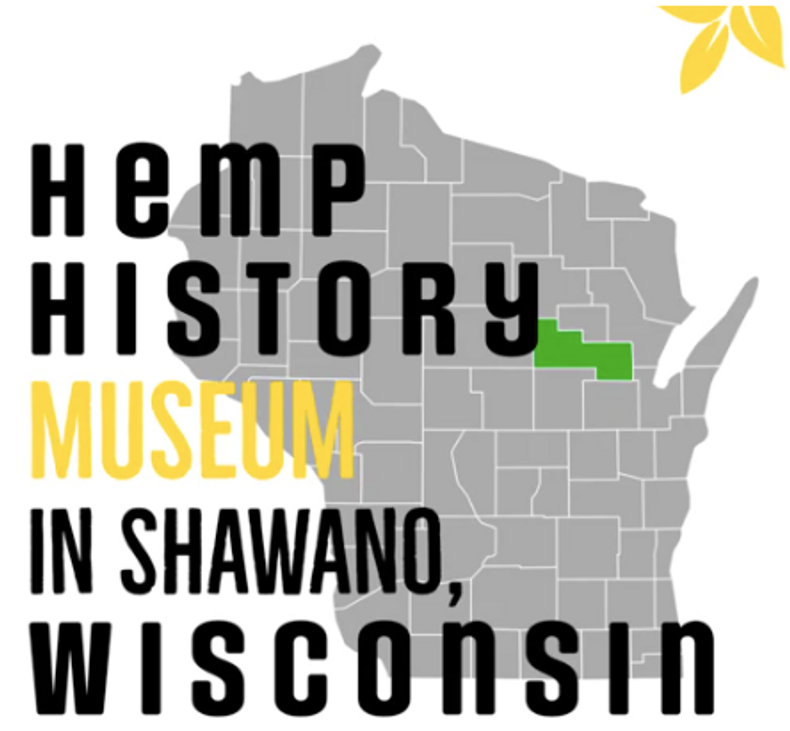
Hemp History Museum in Shawano, Wisconsin
Here at Happy Trails, we pride ourselves on educating our customers on the world of cannabis medicine. Since 2018 our cannabinoid consultants have been working hard to share important knowledge on hemp products with others and help find remedies for those who need it. We value our customers and think our knowledge makes us valuable to people looking to start their journey with cannabis medicine.
Each of our stores are inviting, but one of them stands out more than the others. At our Shawano location, we have set up a hemp museum display. Our hemp museum showcases materials made from hemp fibers and information about the hemp industry in Wisconsin. We acknowledge that hemp has a long history in our state as well as the world. Cannabis Activist, Project Director at Hempstead Project HEART and dear friend, Marcus Grignon was instrumental in putting together this hemp museum. Hempstead Project HEART provides economic opportunities and tribal sovereignty for Native Americans interested in hemp. We are honored to house amazing artifacts that have given us another platform for educating others.
Additionally, we provide concise articles on a variety of topics regarding hemp in blog posts. Read on below to find more information about hemp history and we encourage you to stop in to enjoy our display in person.
What is Hemp?
Hemp is typically a low-THC variety of the cannabis plant. In the US hemp is legally allowed to contain a THC content of only 0.3% or less. This includes any edible products containing extracts from hemp. Hemp is grown for fiber, food, and medicine.
Hemp History
Cannabis has been used across the world as medicine and fiber for millenia. Central Asia is where hemp originated. Records in China indicate that hemp was cultivated there for its fiber as early as 2800 BCE. During the Christian era, cultivation spread to the mediterranean. Cannabis is likely mentioned in the Bible, referred there as the hebrew word kaneh-bosm. Later, in the middle ages cannabis cultivation found its way into the rest of Europe. North American cultivation began in the 1600s and during that time Virginia, Massachusetts and Connecticut colonies were required to grow hemp crops.
Wisconsin Hemp History
Among the states, Wisconsin has had a rich history of hemp production. By 1920, Wisconsin had become the leading hemp producer and had the most acreage. WW2 brought a demand for hemp fiber when foreign fiber supplies were cut off. This sparked a slogan “Hemp for Victory” created by the federal War Hemp Program.
However, the end of the war brought the dwindling of hemp production as the federal government withdrew any interest in the crop. During this time, the association of hemp with marijuana use increased despite them being different varieties of plant. Marijuana for recreational use was effectively taxed from existence due to The 1937 Marijuana Tax Act.
Hemp production decreased further and by 1950 there were no buyers anymore. The last Wisconsin hemp mill later closed in 1957. All cannabis varieties became listed as Schedule 1 controlled substances under the Controlled Substances Act of 1970.
This lasted until The Agriculture Improvement Act of 2018, also known as the 2018 Farm Bill, removed hemp from the DEAs list of controlled substances once again allowing production of hemp.
Various applications of hemp products
Hemp is an extremely versatile plant that is harvested for both its seeds and its fiber. Seeds may be consumed by both humans and animals. Caged bird feed is the biggest commercial use for the seeds. Seeds can be eaten raw and are often marketed as a health food product. Hemp can be turned into milk as a non-dairy alternative. Oil from the seeds also can be made into many things, including paints, varnishes and soaps.
Fiber can be turned into many products such as cordage and fabrics. Hemp fabric can be used to make shoes and clothing. Hemp can be used as an alternative to wood pulp and can be made into paper. It may be used as a building material a product called hempcrete combines lime binder with hemp and creates a product similar to concrete. Hemp also can be used for insulation as an alternative to fiberglass.
Examples of some of the aforementioned products can be found in the museum located in Shawano. We hope you visit us.

My name is Amber. I am a cannabinoid consultant and columnist for Happy Trails. I have a Bachelor of Science in Biology, I enjoy learning about things I have passion for, and my family lovingly calls me a “human encyclopedia”. |
References
Benet, S. (1975). EARLY DIFFUSION AND FOLK USES OF HEMP (V. Rubin & L. Comitas, Eds.). Cannabis and Culture, 39-49.
Deitch, R., & Gutierres, T. (2014, February 13). Hemp: American history revisited [electronic resource] : the plant with a divided history : Deitch, Robert, 1950- : Free Download, Borrow, and Streaming. Internet Archive. Retrieved April 21, 2022, from https://archive.org/details/isbn_9780875862064
History of cannabis - Lambert Initiative for Cannabinoid Therapeutics. (n.d.). The University of Sydney. Retrieved April 21, 2022, from https://www.sydney.edu.au/lambert/medicinal-cannabis/history-of-cannabis.html
Marijuana - HISTORY. (2017, May 31). History.com. Retrieved April 21, 2022, from https://www.history.com/topics/crime/history-of-marijuana
Willis, M. (2021, July 25). The Return of Hemp. JSTOR Daily. https://daily.jstor.org/the-return-of-hemp/

